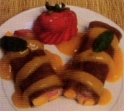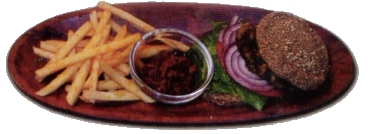|
|
Dehydrator Tips
and Techniques
 You can use your Excalibur Dehydrator to: You can use your Excalibur Dehydrator to:
- Speed up the marinating of vegetables (when cut
properly and placed in a marinade bath, in a covered, glass, container for 1 - 2 hours, it
will soften the vegetables and create a cooked texture and appearance, besides
intensifying the flavors in the food).
- Thicken sauces (placed in an open, glass container
for 2 3 hours, it will reduce the liquid content, much like “reduction” in
traditional cooking).
- Warm food to above body temperature, so it is
warming rather than cooling to the body, yet it maintains it’s enzymatic integrity.
- Slow “bake” sprouted breads
- Soften coconut oil gently.
- Create (sprouted, seasoned) dehydrated travel snacks
like sunflower seeds, pumpkin seeds, tamari almonds and trail mixes
- Create crispy crunchy crackers and chips (also pie
crusts, cookies, cakes, brownies, granola bars, and more!
- Create Veggie Wraps by placing a piece of kale or
chard in the dehydrator fora few minutes, you have an instant wrap for a salad, or
sandwich! The dehydrator will soften the kale or chard so it can be easily rolled.
- Dehydrate your fresh herbs, spices, fruits and vegetables Purchase
in bulk or grown your own, and dehydrate to have for later. I purchase lugs of
tomatoes in season at a farmers market and dehydrate them to make sun dried tomatoes
usually cost $10+ a pound!
- Speed up the time it takes to make fermented foods
Important Concepts when dehydrating Raw foods Foods
1. Temperature vs. Air Temperature
 The temperature
readings on the Excalibur Dial represent food temperature. During the dehydration process
the food temperature is 20 to 25 degrees cooler than the air temperature because of
evaporation. As moisture evaporates from the foods surface it acts as a cooling process
keeping the food temperature below the actual air temperature. The air temperature will
generally be higher that what the dial reads. The temperature
readings on the Excalibur Dial represent food temperature. During the dehydration process
the food temperature is 20 to 25 degrees cooler than the air temperature because of
evaporation. As moisture evaporates from the foods surface it acts as a cooling process
keeping the food temperature below the actual air temperature. The air temperature will
generally be higher that what the dial reads.
2. Proper Dehydration Temperatures
 The
most frequently quoted and accurate temperature is 118°F (Food Temperature) based on the
book “Enzyme Nutrition by Dr. Edward Howell. Because of the difference in food
temperature and air temperature it is safe to dehydrate at dial settings up to 145°F for
the first several hours because the food temperature will never exceed 118°F. After the
first 2 to 3 hours the temperature should be turned down to a lower setting around 105°F
for the remaining time. Following this procedure will dramatically shorten the time it
takes to dehydrate raw foods, which will decrease the potential of mold or bacteria from
growing on the food. Excalibur’s adjustable thermostat with exclusive HyperwaveTM
fluctuation is specifically designed to maximize food quality and drying efficiency while
minimizing the drying time. The
most frequently quoted and accurate temperature is 118°F (Food Temperature) based on the
book “Enzyme Nutrition by Dr. Edward Howell. Because of the difference in food
temperature and air temperature it is safe to dehydrate at dial settings up to 145°F for
the first several hours because the food temperature will never exceed 118°F. After the
first 2 to 3 hours the temperature should be turned down to a lower setting around 105°F
for the remaining time. Following this procedure will dramatically shorten the time it
takes to dehydrate raw foods, which will decrease the potential of mold or bacteria from
growing on the food. Excalibur’s adjustable thermostat with exclusive HyperwaveTM
fluctuation is specifically designed to maximize food quality and drying efficiency while
minimizing the drying time.
3. Enzyme Facts
 Enzymes
are most susceptible to damage by high heat while they are in a wet state. This is why
cooking is so damaging to enzymes. Dehydration however, the process of removing the foods
moisture through evaporation, uses far less heat than cooking or baking. As the food
becomes drier, the enzymes become more stable, and can withstand temperatures up to
150°F. Enzymes
are most susceptible to damage by high heat while they are in a wet state. This is why
cooking is so damaging to enzymes. Dehydration however, the process of removing the foods
moisture through evaporation, uses far less heat than cooking or baking. As the food
becomes drier, the enzymes become more stable, and can withstand temperatures up to
150°F.
Excalibur®, Parallex™ and
Teflex™ are registered trademarks of Excalibur/Killer Baits Inc. |


